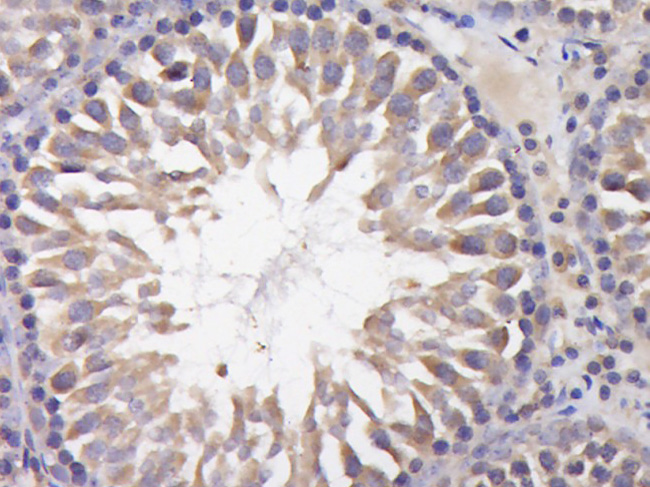
Rabbit Anti-phospho-CBL (Tyr700)antibody
phospho-C CBL (Tyr700); CBL2 (phospho-Tyr700); CBL2 (phospho-Y700); p-CBL2 (Tyr700); p-CBL2 (Y700); C CBL; Cas-Br-M (murine) ecotropic retroviral transforming sequence; Casitas B lineage lymphoma proto oncogene; CBL 2; CBL2; E3 ubiquitin protein ligase CB
View History [Clear]
Details
Product Name phospho-CBL (Tyr700) Chinese Name 磷酸化原癌基因CBL2抗体 Alias phospho-C CBL (Tyr700); CBL2 (phospho-Tyr700); CBL2 (phospho-Y700); p-CBL2 (Tyr700); p-CBL2 (Y700); C CBL; Cas-Br-M (murine) ecotropic retroviral transforming sequence; Casitas B lineage lymphoma proto oncogene; CBL 2; CBL2; E3 ubiquitin protein ligase CBL; Oncogene CBL2; Proto oncogene c CBL; RGD1561386; RING finger protein 55; RNF55v Signal transduction protein CBL; 4732447J05Rik; CBL_HUMAN. Product Type Phosphorylated anti Research Area Tumour immunology transcriptional regulatory factor b-lymphocyte Immunogen Species Rabbit Clonality Polyclonal React Species Human, Rat, (predicted: Mouse, Dog, Pig, Cow, Horse, ) Applications ELISA=1:5000-10000 IHC-P=1:100-500 IHC-F=1:100-500 ICC=1:100-500 IF=1:100-500 (Paraffin sections need antigen repair)
not yet tested in other applications.
optimal dilutions/concentrations should be determined by the end user.Theoretical molecular weight 100kDa Cellular localization cytoplasmic The cell membrane Form Liquid Concentration 1mg/ml immunogen KLH conjugated synthesised phosphopeptide derived from human C CBL around the phosphorylation site of Tyr700: TE(p-Y)MT Lsotype IgG Purification affinity purified by Protein A Buffer Solution 0.01M TBS(pH7.4) with 1% BSA, 0.03% Proclin300 and 50% Glycerol. Storage Shipped at 4℃. Store at -20 °C for one year. Avoid repeated freeze/thaw cycles. Attention This product as supplied is intended for research use only, not for use in human, therapeutic or diagnostic applications. PubMed PubMed Product Detail This gene is a proto-oncogene that encodes a RING finger E3 ubiquitin ligase. The encoded protein is one of the enzymes required for targeting substrates for degradation by the proteasome. This protein mediates the transfer of ubiquitin from ubiquitin conjugating enzymes (E2) to specific substrates. This protein also contains an N-terminal phosphotyrosine binding domain that allows it to interact with numerous tyrosine-phosphorylated substrates and target them for proteasome degradation. As such it functions as a negative regulator of many signal transduction pathways. This gene has been found to be mutated or translocated in many cancers including acute myeloid leukaemia. Mutations in this gene are also the cause of Noonan syndrome-like disorder. [provided by RefSeq, Mar 2012]
Function:
Adapter protein that functions as a negative regulator of many signaling pathways that are triggered by activation of cell surface receptors. Acts as an E3 ubiquitin-protein ligase, which accepts ubiquitin from specific E2 ubiquitin-conjugating enzymes, and then transfers it to substrates promoting their degradation by the proteasome. Recognizes activated receptor tyrosine kinases, including KIT, FLT1, FGFR1, FGFR2, PDGFRA, PDGFRB, EGFR, CSF1R, EPHA8 and KDR and terminates signaling. Recognizes membrane-bound HCK and other kinases of the SRC family and mediates their ubiquitination and degradation. Participates in signal transduction in hematopoietic cells. Plays an important role in the regulation of osteoblast differentiation and apoptosis. Essential for osteoclastic bone resorption. The Tyr-731 phosphorylated form induces the activation and recruitment of phosphatidylinositol 3-kinase to the cell membrane in a signaling pathway that is critical for osteoclast function.
Subunit:
Interacts (phosphorylated at Tyr-731) with PIK3R1. Associates with NCK via its SH3 domain. The phosphorylated C-terminus interacts with CD2AP via its second SH3 domain. Binds to UBE2L3. Interacts with adapters SLA, SLA2 and with the phosphorylated C-terminus of SH2B2. Interacts with EGFR, SYK and ZAP70 via the highly conserved Cbl-N region. Also interacts with SORBS1 and INPPL1/SHIP2. Interacts with phosphorylated LAT2. May interact with CBLB (By similarity). Interacts with ALK, AXL, BLK, FGR and FGFR2. Interacts with CSF1R, EPHB1, FLT1, KDR, PDGFRA and PDGFRB; regulates receptor degradation through ubiquitination. Interacts with HCK and LYN. Interacts with TEK/TIE2 (tyrosine phosphorylated).
Subcellular Location:
Cytoplasm. Cell membrane. Note=Colocalizes with FGFR2 in lipid rafts at the cell membrane.
Post-translational modifications:
Phosphorylated on tyrosine residues by ALK, EGFR, SYK, FYN and ZAP70 (By similarity). Phosphorylated on tyrosine residues in response to FLT1 and KIT signaling. Phosphorylated on tyrosine residues by INSR and FGR. Phosphorylated on several tyrosine residues by constitutively activated FGFR3. Not phosphorylated at Tyr-731 by FGFR3. Phosphorylated on tyrosine residues by activated CSF1R, PDGFRA and PDGFRB. Phosphorylated on tyrosine residues by HCK.
Ubiquitinated, leading to its degradation via the proteasome.
DISEASE:
Defects in CBL are the cause of Noonan syndrome-like disorder with or without juvenile myelomonocytic leukemia (NSLL) [MIM:613563]. A syndrome characterized by a phenotype reminiscent of Noonan syndrome. Clinical features are highly variable, including facial dysmorphism, short neck, developmental delay, hyperextensible joints and thorax abnormalities with widely spaced nipples. The facial features consist of triangular face with hypertelorism, large low-set ears, ptosis, and flat nasal bridge. Some patients manifest cardiac defects.
Similarity:
Contains 1 Cbl-PTB (Cbl-type phosphotyrosine-binding) domain.
Contains 1 RING-type zinc finger.
Contains 1 UBA domain.
SWISS:
P22681
Gene ID:
867
Database links:Entrez Gene: 867 Human
Entrez Gene: 12402 Mouse
Omim: 165360 Human
SwissProt: P22681 Human
SwissProt: P22682 Mouse
Unigene: 504096 Human
Unigene: 266871 Mouse
C CBL是Ubiquitin一蛋白酶体(ubiquitin proteasome)通路中的一个新的RINGFinger型Ubiquitin连接酶(ubiquitinligase ,E3).C CBL可以介导受体酪氨酸激酶和非受体酪氨酸受体激酶的降解.Product Picture
References (0)
No References
Bought notes(bought amounts latest0)
No one bought this product
User Comment(Total0User Comment Num)
- No comment



 +86 571 56623320
+86 571 56623320
 +86 18668110335
+86 18668110335

